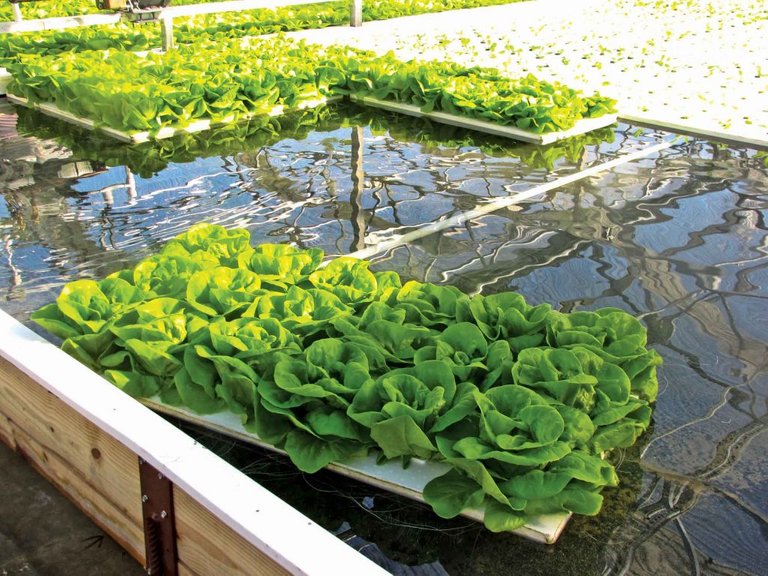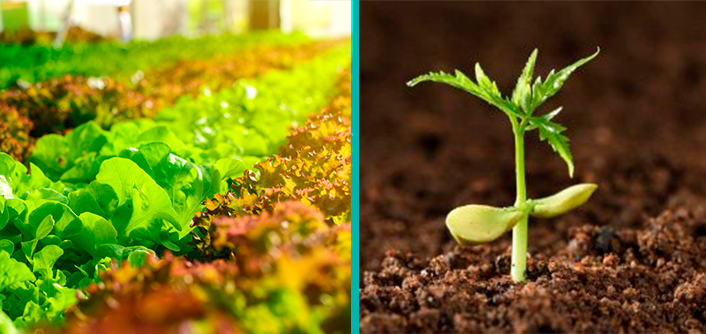HIDROPONÍA: CULTIVO DE PLANTAS SIN SUELO

FUENTE
Salir al jardín y escoger alguna legumbre fresca para la comida, estando en un balcón de un departamento a 10 pisos del suelo suena como un sueño, pero es la realidad. ¿un jardín sin suelo?. Si los jardines urbanos son jardines hidropónicos quiere decir sin suelo.
La hidroponía se deriva del griego hydro (agua) y ponos (labor de trabajo), lo cual significa trabajo en agua. Por lo tanto, la hidroponía es un sistema de producción en el cual las raíces de las plantas no se encuentran establecidas en el suelo, sino en un sustrato o en la misma solución nutritiva utilizada. En la solución nutritiva, como su nombre dice, se encuentran disueltos los elementos necesarios para el crecimiento de la planta.

FUENTE
En un jardín hidropónico, las plantas crecen en una solución liquida que contiene todos los nutrientes que hay normalmente en suelos ricos y fértiles. Tanto los hortelanos dementicos como los productores comerciales han aplicado este sistema de cultivo para todo tipo de plantas, desde alcachofas hasta camotes. Incluso, se pueden cultivar arbustos y árboles frutales.
Métodos hidropónicos
Desde hace siglos se sabe que las plantas pueden crecer sin suelo. A mediados del siglo XIX, los hombres de ciencia buscaron soluciones nutricionales que pudieran ayudar a las plantas a crecer mejor. El término “hidroponía” fue creado en el decenio de los veintes por un investigador californiano. Y en la década de los cuarentas, durante la Segunda Guerra Mundial, se emplearon las técnicas hidropónicas para cultivar legumbres destinadas a los soldados estacionados en la isla del pacifico. En años recientes esta técnica a alcanzado popularidad.
Tipos de jardines hidropónicos:
Existen varios tipos de jardines hidropónicos; el cultivo en agua y en arena.
El cultivo en agua, consiste en que se colocan las plantas sobre un soporte hecho de tela de alambre. Las raíces de las plantas cuelgan por la tela y quedan sumergidas en un depósito en el que hay una solución quimica y que bombea constantemente aire en el líquido para aportar oxígeno a las raíces.

FUENTE
El cultivo en arena es más sencillo y es el que se emplea más comúnmente. Aquí, las plantas se ponen en u recipiente lleno de arena, grava fina u otro material similar, como arenilla. Este material sostiene las plantas y permite que circule el aire entre las raíces sin necesidad de bombearlo.

FUENTE
La solución quimica nutritiva se puede añadir al jardín de arena en varias formas. En jardines pequeños, simplemente se vierte con una frecuencia que depende de las necesidades de las plantas. Algunos jardines hidropónicos tienen sistemas automáticos que gotean de manera continua la solución sobre los recipientes.
Importante saber
La jardinería hidropónica no está libre de problemas. Las plantas pueden contraer las mismas enfermedades y plagas que las plantas cultivadas en el suelo. Tienen, además, las mismas exigencias de luz.
La jardinería hidropónica presenta varias ventajas:
Requiere de mucho menos mano de obra que la jardinería tradicional, ya que no se necesita cavar, arar o arrancar hierbas indeseables.
Las legumbre cultivadas con hidroponía maduran más rápidamente y su tamaño es mayor que las cultivadas en el suelo.
Las plantas en hidroponía sus raíces no se dispersan como en el suelo para buscar nutrientes, lo que hace más fácil cultivar en espacios reducidos como balcones y azoteas.
Realidad

FUENTE
Es muy poco probable que la hidroponía llegue a reemplazar la jardinería tradicional, por una importante razón: mucha gente disfruta cavando y plantando en el suelo. Pero las ciudades están invadiendo el campo y la tierra se hace cada vez más escasa. La jardinería hidropinica permitirá que más gente tenga jardines propios. Y puede ayudar a alimentar a la creciente población del mundo.
Que interesante información, espero le haya gustado mucho nos, vemos en la próxima publicación
Las imágenes fueron tomadas de internet, se presentan sus fuentes en la parte inferior.
Referencias
Libro del año 1984, editorial Cumbre, S.A
https://www.intagri.com/articulos/horticultura-protegida/la-hidroponia-cultivos-sin-suelo
Final Español: #
Final ingles:#
[ENG]
HYDROPONICS: GROWING PLANTS WITHOUT SOIL .

SOURCE
Going out into the garden and picking some fresh vegetables for lunch while standing on a balcony of an apartment 10 stories off the ground sounds like a dream, but it is reality. a garden without soil?. If urban gardens are hydroponic gardens it means without soil.
Hydroponics is derived from the Greek hydro (water) and ponos (work labor), which means work in water. Therefore, hydroponics is a production system in which the roots of the plants are not established in the soil, but in a substrate or in the same nutrient solution used. In the nutrient solution, as its name says, the elements necessary for plant growth are dissolved.

SOURCE
In a hydroponic garden, plants grow in a liquid solution that contains all the nutrients normally found in rich, fertile soils. Both dementia gardeners and commercial growers have applied this growing system to everything from artichokes to sweet potatoes. Shrubs and fruit trees can even be grown.
Hydroponic methods
It has been known for centuries that plants can grow without soil. In the mid-19th century, scientists searched for nutritional solutions that could help plants grow better. The term "hydroponics" was created in the 1920s by a Californian researcher. And in the 1940s, during World War II, hydroponic techniques were used to grow vegetables for soldiers stationed on the Pacific island. In recent years this technique has gained popularity.
Types of hydroponic gardens:
There are several types of hydroponic gardens; cultivation in water and in sand.
Water culture consists of placing the plants on a support made of wire mesh. The roots of the plants hang through the fabric and are submerged in a tank in which there is a chemical solution that constantly pumps air into the liquid to provide oxygen to the roots.

SOURCE
Sand culture is simpler and is the most commonly employed. Here, plants are placed in a container filled with sand, fine gravel or other similar material, such as grit. This material supports the plants and allows air to circulate between the roots without the need for pumping.

SOURCE
The nutrient chemical solution can be added to the sand garden in several ways. In small gardens, it is simply poured in at a frequency that depends on the needs of the plants. Some hydroponic gardens have automatic systems that continuously drip the solution over the containers.
Important to know
Hydroponic gardening is not without its problems. Plants can get the same diseases and pests as plants grown in soil. They also have the same light requirements.
Hydroponic gardening has several advantages:
It requires much less labor than traditional gardening, as there is no digging, plowing or pulling undesirable weeds.
Legumes grown hydroponically mature more quickly and are larger in size than those grown in soil.
Hydroponic plants do not spread their roots as they do in soil to search for nutrients, making it easier to grow in confined spaces such as balconies and rooftops.
Reality

SOURCE
It is highly unlikely that hydroponics will ever replace traditional gardening, for one important reason: many people enjoy digging and planting in the ground. But the cities are encroaching on the countryside and land is becoming increasingly scarce. Hydropinic gardening will allow more people to have their own gardens. And it can help feed the world's growing population.
What interesting information, I hope you liked it a lot, see you in the next publication
The images were taken from the internet, their sources are presented at the bottom.
References
Book of the year 1984, Editorial Cumbre, S.A
https://www.intagri.com/articulos/protected-horticulture/la-hidroponia-cultivos-sin-soil
Spanish Final: #
English ending:#
Su post ha sido valorado por @ramonycajal
@ramonycajal GRACIAS POR VALORAR MI POST.
Congratulations @edithb! You have completed the following achievement on the Hive blockchain and have been rewarded with new badge(s):
Your next target is to reach 2500 upvotes.
You can view your badges on your board and compare yourself to others in the Ranking
If you no longer want to receive notifications, reply to this comment with the word
STOPSupport the HiveBuzz project. Vote for our proposal!